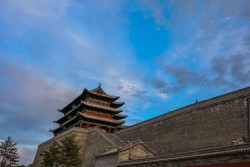

Introducing Datong Huayan Temple
Huayan Temple was established during the Liao and Jin dynasties (11th-12th centuries CE). Huayan Temple underwent restructuring during the Ming Dynasty, being split into upper and lower sections. Huayan Temple was later reunified in 1963. The lower temple accommodates the Sutra Hall, erected in 1038, while the upper temple houses the Mahavira Hall, constructed in 1062. The Smiling Bodhisattva statue within the Sutra Hall has become emblematic of Datong, admired for its charming smile characterized by parted lips and visible teeth. The term "Huayan," derived from the Avatamsaka Sutra, known as the Flower Garland Sutra, translates to "Flower Garland" in Chinese. Huayan Buddhism held sway in China from the sixth to ninth century, reaching its zenith during the Tang dynasty (618-907 CE) before waning in influence thereafter. Despite its decline, Huayan scriptures remain subjects of study, significantly impacting Chan Buddhism.
Datong Huayan Temple Fast Facts
• Chinese Name: Hua Yan Si 华严寺
• Best Time to Visit: May, Jun, Sept & Oct
• Recommended Visiting Hours: About 3 hours
• Things to Do: Buddhist culture, tradtional Chinese architecture
• Opening Hours: 08:30 to 17:30 from Apr to Oct; 08:30 to 17:00 from Nov to Mar
• Entrance Fee: CNY 80; free for children under 1.2m (3.9ft).
• Address: No. 459, Xiasipo Street, Pingcheng District, Datong
Watch this video showcasing Datong Huayan Temple
Kind Notice: You can not watch this video if you are in China (YouTube is blocked in China).
Why Visit Datong Huayan Temple
The Mahavira Hall at Huayan Temple, originally established in the year 1062 during the Liao Dynasty, was reconstructed in 1140 during the Jin Dynasty, retaining its original location within the temple grounds. Notably, this hall stands as one of the largest existing temple halls from the Liao and Jin dynasties in China. Similarly, the Sutra Hall, dating back to 1038 under the Liao dynasty, maintains its architectural style from that era alongside the Mahavira Hall. Together, these halls form an artistic complex showcasing ancient Chinese architecture, sculptures, frescoes, and inscriptions, representing a rich cultural amalgamation of religion and politics.
What to Expect at Datong Huayan Temple
The Huayan name originates from the Avatamsaka Sutra, also known as the Huayan Sutra in China. Along its primary north-south axis, the temple complex boasts over 30 structures, including the Temple Gate (Hall of Heavenly Kings), Universal Light Hall, Mahavira Hall, Sutra Hall, and Huayan Pagoda. While the Mahavira Hall and Sutra Hall, dating back to the Liao and Jin dynasties, stand as original structures, numerous buildings underwent restoration during the Qing Dynasty. Renowned for her enchanting smile featuring parted lips and visible teeth, the Smiling Bodhisattva within the Sutra Hall has become emblematic of Datong. Standing at a slender 2 meters (6.5 feet) tall, this figure is celebrated as a "particularly beautiful" masterpiece of sculpture.
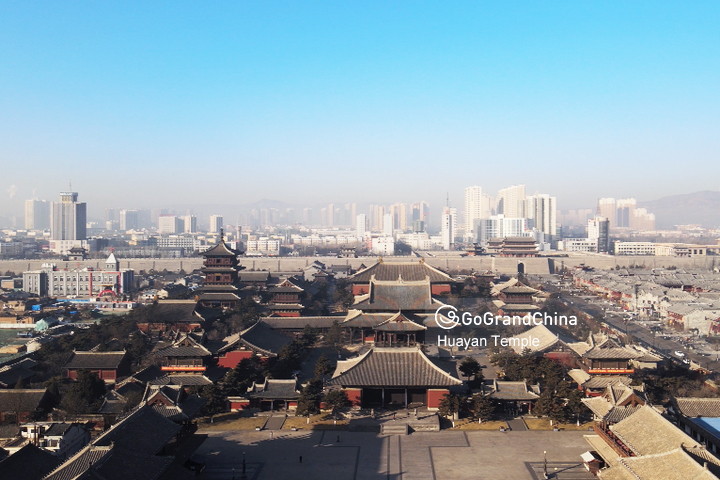
The Universal Light Hall
The Hall of Universal Light, originating from the Avatamsaka Sutra, served as the venue for Buddha's teachings of the scripture. Spanning seven bays across and six bays deep, this structure features a double eave hip-and-gable roof design. Within, the Three Worthies of Huayan, revered figures in Huayan Buddhism, are enshrined: Buddha Vairocana at the center, flanked by Bodhisattva Manjushri on the left and Samantabhadra on the right. Originating during the Tang dynasty, the Huayan school of Buddhism finds its philosophical roots in the Avatamsaka Sutra, which portrays a cosmic perspective where all phenomena are perceived as empty and infinitely interconnected by Buddha Vairocana. Vairocana, also known as 'the Brilliant One,' radiates luminous light and is regarded as the primal Buddha, the foundation of existence, and the source from which all phenomena arise. Adorning the surrounding walls are murals depicting scenes from the final and longest chapter of the Avatamsaka Sutra, portraying the journey of Youth Sudhana as he seeks enlightenment under the guidance of fifty-three spiritual mentors.
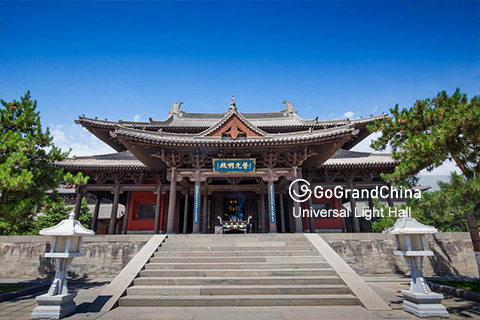
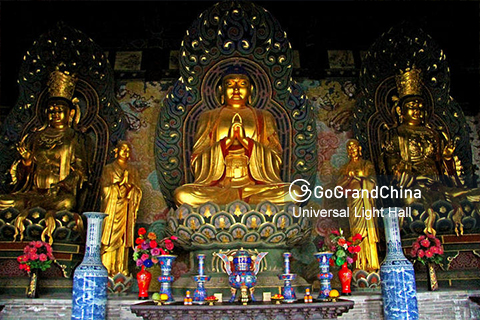
Mahavira Hall
Constructed in 1062 AD during the Liao Dynasty (907-1125), the Mahavira Hall features a hip-roof design and underwent renovation in 1140 during the Jin Dynasty (1115-1234). While its structural frame reflects the Liao period, some bracketing and roof frames exhibit characteristics of the Jin era. Spanning nine bays across and five bays deep (54m x 28m, or 177ft x 92ft), it stands as the largest wooden hall in China before the Ming Dynasty (1368–1644). Adorning each end of the main ridge are giant Chiwen, legendary creatures with dragon heads and fish tails, embellished with colorful glaze. These Chiwen, comprised of eight pieces of colored glazed tiles and measuring 4.5 meters in height, served to safeguard the hall against fire. Notably, there are two Chiwen, one original from the Jin Dynasty and the other replaced during the Ming Dynasty. Despite its age, the northern Chiwen retains its vivid colors without fading. At the heart of the hall sits Shakyamuni, the central Buddha, enthroned atop a tall seat crafted from gilded and painted wood. Surrounding him are the Five Directional Buddhas—Akshobhya (East), Ratnasambhava (South), Amitabha (West), and Amoghasiddhi (North)—carved during the Xuande period (1426–1435) of the Ming dynasty. Additionally, the hall houses twenty Protector Deities sculpted with lifelike expressions, representing Ming dynasty relics. Large murals depicting Buddhist legends adorn the surrounding walls, created during the reign of Emperor Guanshu in the Qing Dynasty (1871-1908). Notably, while Mahavira Halls in Chinese Buddhist temples typically face south, the Mahavira Hall of Huayan Temple stands uniquely oriented toward the east, possibly due to its previous function as a Liao Dynasty ancestral temple.
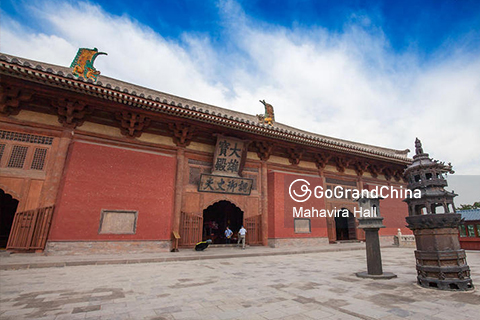
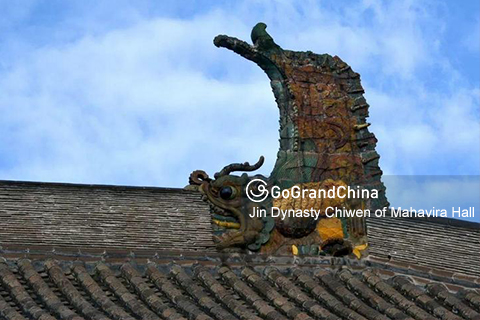
Huayan Pagoda
Huayan Pagoda stands as the second wooden pagoda, following in the footsteps of the millennia-old Wooden Pagoda of Yingxian County, which has endured for nearly ten centuries. Rising to a height of 43.5 meters and boasting a square shape, it is a remarkable architectural achievement. Beneath the pagoda lies the Thousand Buddhas Palace, constructed from 100 tons of pure copper. Within its 500-square-meter expanse, the palace houses a precious Buddha relic alongside a thousand copper Buddhist images. This fusion of modern innovation with traditional craftsmanship epitomizes the essence of the structure.
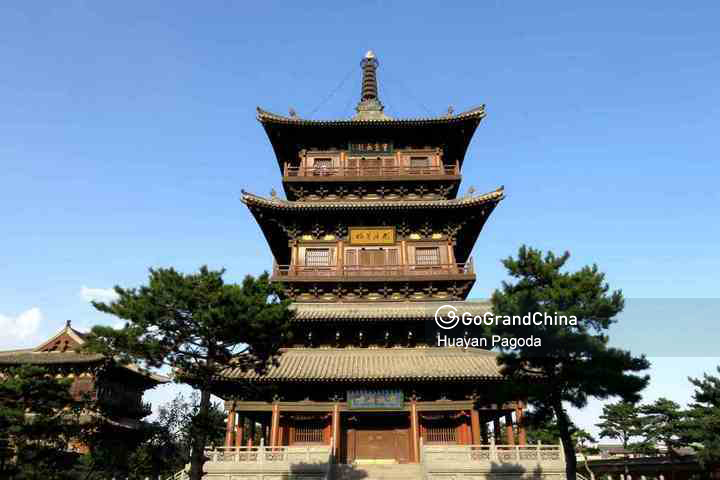
The Sutra Hall
Established in 1038 during the Liao dynasty (907–1125), the Sutra Hall boasts dimensions of five bays wide and four rooms deep, featuring single eave gable and hip roofs. Within its confines, a total of 29 statues of Buddhist deities are enshrined, including Sakyamuni, Dīpankara Buddha, Maitreya, Guanyin, Manjushri, Samantabhadra, and Ksitigarbha. The arrangement of these images symbolizes the scene of Buddha delivering summons on the Avatamsaka Sutra. Functioning as the temple's library, the Sutra Hall accommodates 38 sutra cabinets designed like miniature buildings from the period. Preserved within are sets of the Chinese Buddhist canon, printed during the Qing dynasty (1644–1911). Particularly noteworthy is the Smiling Bodhisattva, depicted with palms together and a slightly open mouth revealing teeth, heralded as an Oriental Venus and a masterpiece of sculpture. These clay-sculpted Buddhist images represent incredible craftsmanship from the Liao Dynasty (916-1125), characterized by lifelike features, esteemed presence, and exquisite detail.
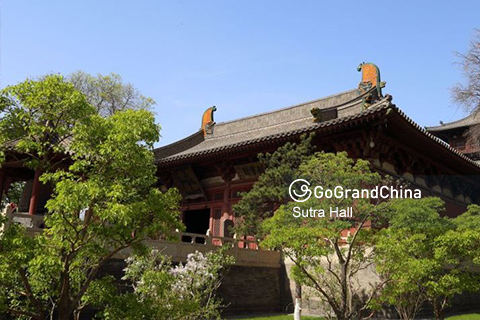
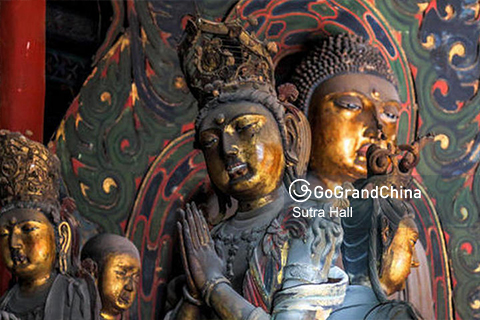
How to Get to Datong Huayan Temple
• Huayan Temple is located inside the newly built Datong City Wall.
• Take No. 15, 4 or 30 bus, get off at Weidudadao Qingyuanjieku Station, head east for several minutes.
• Rent a car/bus from GGC to enjoy a hassle free private transfer from hotels in Datong to Huayan Temple.